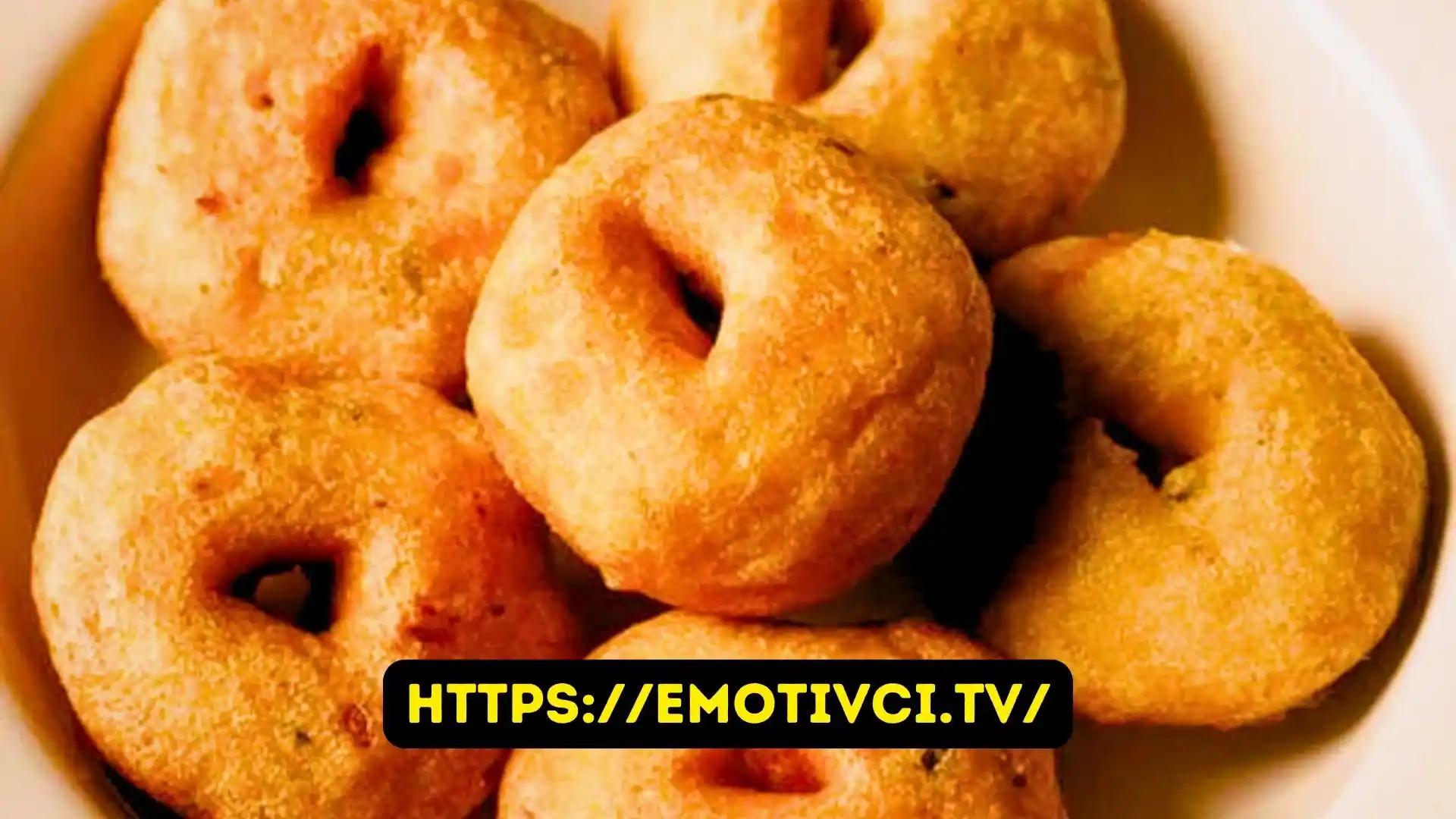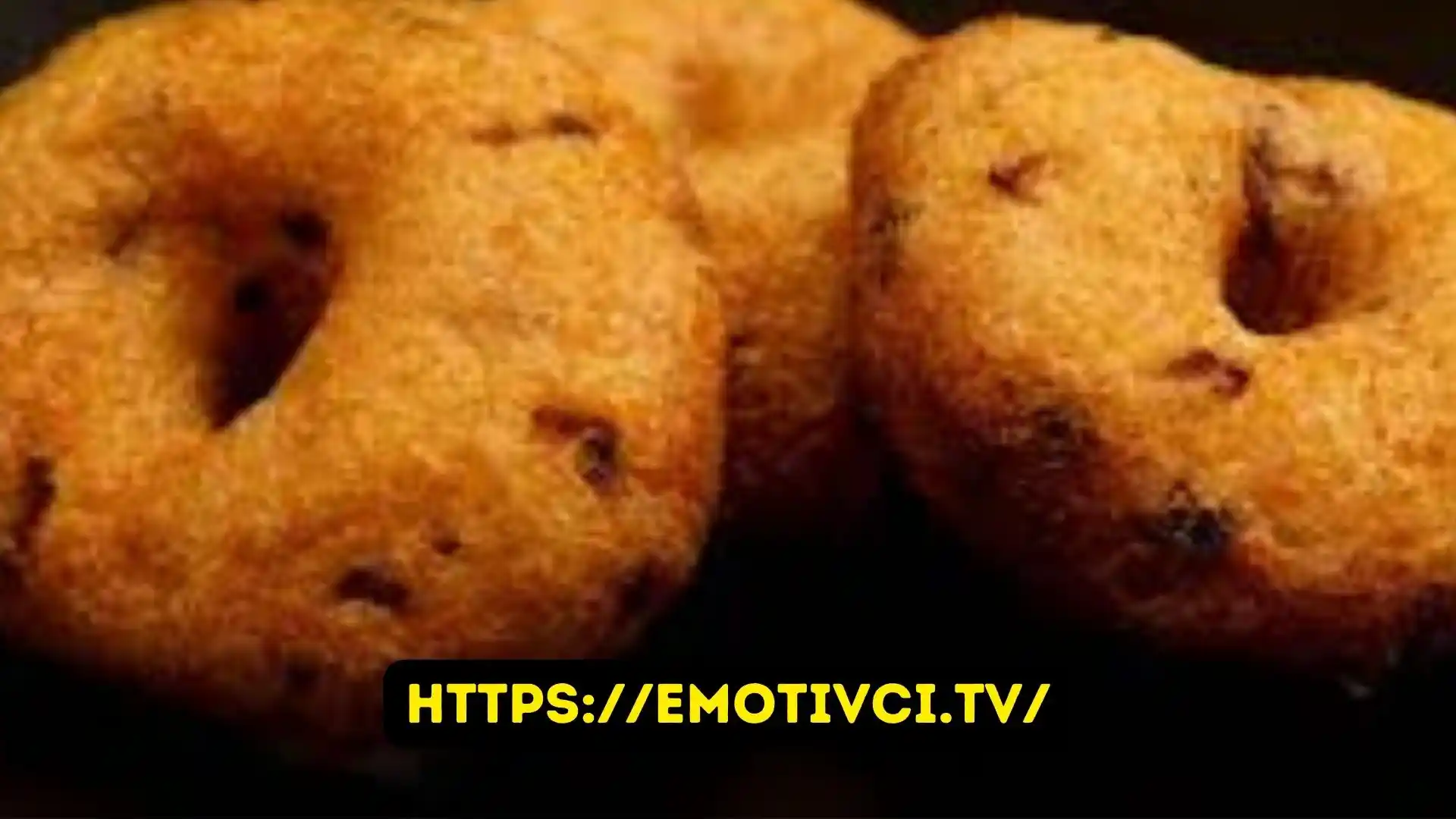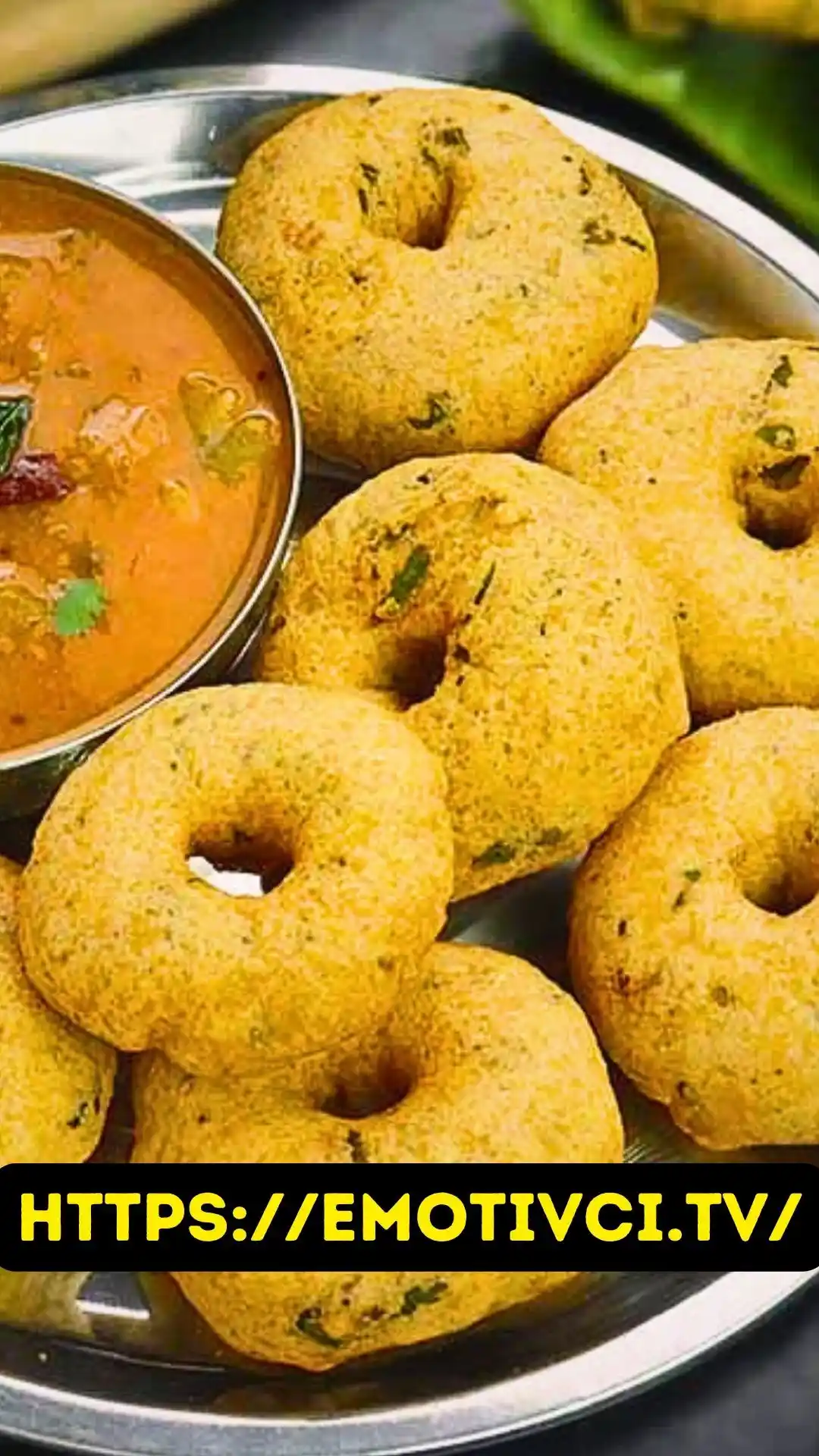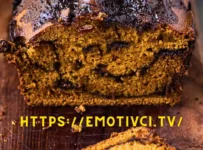Crispy, Fluffy, and Oh-So-Delicious: The Ultimate Guide to Making Medu Vada at Homae
Suppose you’re a fan of South Indian cuisine. In that case, you’ve probably fallen in love with the crisp, fluffy, and utterly irresistible Medu Vada. These donut-shaped lentil fritters are a staple breakfast item in many South Indian homes and restaurants, often served with tangy Coconut Chutney or comforting Tiffin Sambar.

But did you know that you can easily recreate this delicious treat in the comfort of your kitchen? In this ultimate guide, we’ll walk you through the traditional, time-tested recipe for making the best Medu Vada at home, complete with troubleshooting tips and tricks to ensure your vadas turn out perfectly every single time.
But First, What Exactly is a Vada?
Before we dive into the recipe, let’s take a moment to appreciate the rich history and diversity of vadas in Indian cuisine. The term “vada” is believed to have originated from the Sanskrit word “vataka.” According to the renowned Indian food historian KT Achaya, these fried delicacies can be traced back to ancient India, 500 BC. Traditionally made vadas are still offered to deities and gods in Hindu temples and homes during puja ceremonies, showcasing their cultural significance.
Indian cuisine is a beautiful tapestry woven from the threads of various regional cuisines. As a result, you’ll find a wide array of vadas across the country. From Masala Vada and Dahi Vada to Batata Vada and the ever-popular Medu Vada, each region, community, and household has a unique take on this beloved snack.
Vadas can be made with various ingredients, including lentils, vegetables, grains, and tapioca pearls. They go by different names, such as bada, wada, or bora, depending on where you are in India.
Medu Vada: A South Indian Specialty
Now, let’s focus on the star of today’s show: the Medu Vada. This traditional South Indian cake has urad dal (black lentils), aromatic spices, and fragrant curry leaves. The word “media” in Kannada means “soft,” while “vada” refers to the crispy Indian fritters. Thus, Medu Vadas are known for their soft, fluffy interior and delightfully crisp exterior.
Across the South Indian states, Medu Vadas are known by various names – Garelu in Telugu, Medhu Vada in Kannada, Ulundhu Vadai in Tamil, and Uzhunnu Vada in Malayalam – and are enjoyed by people of all ages.
In Telugu-speaking regions, they are even offered during special occasions like Varalakshmi Vratam, Gouri Puja, Diwali, and Durga Navratri. Adding spices and herbs to the batter may vary depending on regional and family traditions, but the core ingredients remain the same.
The popularity of South Indian dishes like Medu Vada, Masala Dosa, Idli, and Rava Dosa has transcended borders, and you can now find them on the menus of restaurants worldwide. But there’s something special about making these delicacies at home. So, let’s begin our journey to creating the perfect Medu Vadas in your kitchen.
The Secret to Perfectly Crisp and Fluffy Vadas
Making Medu Vadas at home is easier if you follow the recipe closely and notice the details. The process involves three main steps:
- Soaking the lentils.
- Grinding them to make a fluffy batter.
- Shaping small portions of the batter before frying them to golden perfection.
Traditionally, the vada batter is ground using a manual stone grinder, Still, modern kitchens are equipped with electric mixer grinders, blenders, or wet grinders that can get the job done just as well.
Creating the perfect batter is the key to achieving that coveted crisp and fluffy texture. This means you’ll need a powerful blender to grind the lentils into a light, airy consistency. Using a low-wattage grinder may result in dense, heavy vadas and even damage your appliance in the process.
The basic Medu Vada recipe uses urad dal, water, and salt. Still, to add an extra layer of flavor, you can include ingredients like crushed black pepper, green chilies, ginger, cumin seeds, curry leaves, and onions. In some households, like mine, we prefer to keep the vadas plain when making them for naivedyam (offerings to the gods), as per our family tradition.
However, when we’re not preparing them for religious purposes, my mom would often add all those aromatic ingredients and sometimes even replace the onions with fresh shredded cabbage for a delightful twist.
Step-by-Step Guide to Making Medu Vada
Now that you understand what goes into making the perfect Medu Vada, let’s walk through the recipe together, step by step.
Preparation:
1. Add 1 cup of urad dal to a large bowl. Wash the dal thoroughly, rubbing it between your hands to remove any powdery residue. Rinse the dal at least 3 to 4 times, draining the water each time.
2. Once the dal is clean, add fresh water to the bowl and allow the lentils to soak for a minimum of 4 to 5 hours. Soaking the dal for an extended period helps create a fluffier batter and increases the volume of the vadas. If you’re short on time, you can soak them for 3 hours, but remember that the texture may differ slightly. When using organic dal, you can even soak it for up to 8 hours with excellent results. While the dal is soaking, place about 1 cup of water in the refrigerator to chill.
Making the Batter:
3. After soaking, drain the water from the dal and give it a final rinse. Make sure to remove all the excess water.
4. Transfer the soaked dal to a grinder or blender jar, and add 1/3 teaspoon of salt.
5. To start the grinding process, sprinkle 3 tablespoons of the chilled water over the dal. Blend the mixture for a short burst, about 25 to 30 seconds.
6. Pause the blender and use a spatula to scrape down the sides and bottom of the jar, releasing any dal that may have stuck.
7. As you continue to grind, add small amounts of water, about 1 ½ teaspoon at a time, evenly sprinkling it over the batter. Whether you’re using a wet grinder or a blender, this process remains the same. Remember to scrape the sides of the jar periodically and continue grinding. At this stage, the batter will be coarse but should remain thick.
8. Keep grinding until the batter appears fluffy, thick, slightly aerated, and white (as shown in the picture). It’s crucial to ensure that your blender doesn’t overheat during the grinding process, as this can impart a bitter taste to the batter.
Checking the Batter Consistency:
9. Perform a simple float test to check if the batter has reached the right consistency. Fill a small bowl with water, then take a small portion of the batter and shape it into a ball. Drop the ball into the water, and if the batter is light and airy, it should float well. If the batter sinks or doesn’t float properly, refer to the notes below for troubleshooting tips on how to fix a runny or thin batter.
10. Once you’re satisfied with the consistency, transfer the batter to a bowl and use your hand to beat it clockwise for 30 to 40 seconds. This step helps to aerate the batter further, making it even fluffier. You can skip this step if you’re using a wet grinder to make the batter.
Adding Flavors (Optional):
11. If you want to make hotel-style Medu Vadas, you can add a pinch of baking soda, half a teaspoon of crushed pepper, 1 to 2 chopped green chilies, 1 tablespoon of finely chopped ginger, 1 sprig of curry leaves, 2 to 3 tablespoons of chopped onion or fresh coconut to the batter. Since I was making these vadas for puja, I didn’t add any extra ingredients to half of the batter. For the other half, I added everything except the baking soda. Once you’ve added your desired flavorings, mix the batter well.
Shaping and Frying the Medu Vadas:
12. Heat oil in a deep pan or kadai over medium flame. Ensure there’s enough oil in the pan so the Medu Vadas can float and fry evenly.
13. Method 1: Dip your fingers in water (make sure the water isn’t dripping from your fingers).
14. Place a small portion of the batter on your fingers. Shape it into a ball.
15. Using your thumb, gently flatten the ball slightly. Then, make a hole in the center of the flattened ball. If the batter sticks to your thumb, dip it in water. Suppose you’re new to making Medu Vadas. In that case, follow the second method described below or practice this technique a few times before frying.
16. Before sliding the Medu Vada into the oil, ensure that the oil is hot enough. Drop a small piece of batter into the oil to test the temperature. The oil is at the right temperature if the batter rises to the surface without browning too quickly.
17. Method 2: Place the batter ball on a greased surface or parchment paper. Flatten it slightly and create a hole in the center, just like the previous method.
18. Once the oil is hot enough, dip your fingers in water, ensuring no excess water is dripping from your hand. Using your left hand, lift the side or corner of the parchment paper and transfer the Medu Vada onto the fingers of your right hand.
19. Facing your palm towards the oil, gently drop the Medu Vada into the hot oil by shaking your fingers. Be careful during this step. Drop the vadas into the oil by gently shaking your fingers, allowing them to slide off your hand.
20. Fry the Medu Vadas over medium flame until they turn golden brown and crisp. If you prefer a deeper golden color, you can increase the flame slightly during the last 2 minutes of frying.
21. Once the vadas are done, remove them from the oil using a slotted spoon and place them on a colander or paper towel to drain excess oil. Continue shaping and frying the vadas in batches until you’ve used up all the batter.
Serving and Storing Medu Vadas:
In our household, we offer the first batch of plain Medu Vadas to the goddess as an offering. Serve the hot, crispy vadas with coconut chutney and tiffin sambar for a truly satisfying and authentic South Indian breakfast experience.

To keep your Medu Vadas crisp for an extended period:
- Place a cooling rack over a baking tray and transfer the fried vadas onto the rack.
- Preheat your oven to a warm setting (80°C to 100°C or 175°F to 200°F) for at least 15 minutes, then place the tray with the vadas inside the oven.
- Keep transferring the remaining vadas to the oven to maintain their crispness as you continue frying them.
Suppose you need to reheat or re-crisp your Medu Vadas. In that case, you can either refry them in hot oil or place them in a preheated oven at 180°C or 360°F for 3 to 4 minutes or until they regain their crispy texture.
Troubleshooting Common Issues:
1. Vadas absorbing too much oil: This can happen if the oil isn’t hot enough or the urad dal has been over-soaked. Additionally, the lentils are ground too long in a wet grinder. In that case, the batter can become extremely light, causing the vadas to absorb more oil. To avoid this, don’t soak the lentils too long; grind them until the batter becomes light and fluffy, and fry the vadas in hot oil.
2. Hard vadas: Soaking the lentils for at least 4 hours is crucial for a fluffy batter. Under-soaked lentils will result in a dense and hard texture. Other factors contributing to hard vadas include not using enough water while grinding, not aerating the batter sufficiently, and using aged lentils that have been sitting on the shelf for too long. Always use fresh lentils and avoid those that have turned yellow.
3. Undercooked vadas: Frying vadas in too hot oil will cause them to brown on the outside while remaining undercooked on the inside. To prevent this, ensure that the oil is hot enough but not smoking, and fry the vadas over medium flame until they turn golden, crisp, and fully cooked.
4. Making vada batter without a wet grinder: While wet grinders are commonly used in hotels, restaurants, and traditional South Indian households to achieve the best fluffy texture, you can still make delicious Medu Vadas using a mixer grinder. I rarely use my large wet grinder and instead rely on my mixer grinder for making vadas at home.
Pro Tips and Notes:

1. Avoid letting the mixer grinder or batter overheat during the grinding process, as this can lead to hard or bitter-tasting vadas. Always use ice-cold water while grinding the lentils.
2. If the batter becomes slightly runny, mix in 1 to 2 tablespoons of rice flour (at room temperature) and beat it well to aerate it. If the batter is still too runny, consider making Punugulu or Urad Dal Bonda instead.
3. Another alternative for fixing a runny batter is to add finely powdered poha (attukulu), which helps absorb excess moisture.
4. Beginners should try shaping the Medu Vadas on a damp cloth, plastic sheet, or cling film before transferring them to the hot oil rather than shaping them directly in their hands or fingers.
5. Add salt to the batter while grinding, as adding it later can cause it to thin out.
6. Use only a small amount of ice-cold water while grinding the batter, adding no more than 1 ½ teaspoon at a time. This means you’ll need to sprinkle the water gradually.
7. If using organic urad dal, you can soak it for up to 8 hours for optimal results.
In conclusion, making Medu Vadas at home is a fun and rewarding experience that allows you to enjoy this beloved South Indian delicacy whenever the craving strikes.
By following this detailed guide and keeping the tips and troubleshooting advice in mind, you’ll be well on your way to creating crispy, fluffy, and utterly delicious vadas that will impress your family and friends. So, go ahead and give this recipe a try – your taste buds will thank you!





